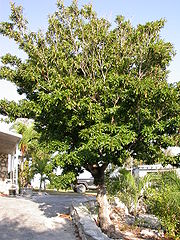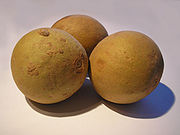 "Hüvelykujjam chikufa,
"Hüvelykujjam chikufa,
mutatóujjam megrázta,
középső ujjam összeszedte,
gyűrűsujjam hazavitte,
és ez az iciri-piciri mind megette..."
Azért költöttem át a mondókát, mert imádom a chiku-t, és mert annyira hiányzik! Mert egyszerűen ha belegondolok, hogy chiku...és megérzem a csodálatos, túlédes zamatát a számban, ahogy szétmállik a napmeleg a nyelvem alatt, és érzem a mézízt, és hallom, ahogy az árusok árulják az utcákon, amikor érik, vagy látom magam előtt Gáborék kertjében a csodálatos, csodatermő chikufát Palolem-en, Goán, akkor úgy érzem, jogtalanság megfosztani Pici Zoét ettől a csodálatos élménytől, hogy ő is megkóstolhassa, és a pici kezével szétmaszatolhassa a barna málló gyümölcshúst, miközben a leve a kis kövér állán folyik egészen a ruhájáig, miközben az Arab-tenger halszagú partján ülünk a lábakon álló kókuszkunyhók alatt hűsölő malacok közelében, és hallgatjuk a halárusok kiabálását....szóval, akkor legalább szóban, babamasszázs alatt próbálom neki átadni az élményt. Legalább had ízlelgessük a szót! Hüvelykujjam chikufa...!
És itt a leírás...milyen érdekes, gondolhattam volna, hogy eredetileg dél-amerikai növény...:
Sapodilla
From Wikipedia, the free encyclopedia
| Sapodilla | ||||||||||||||||
|---|---|---|---|---|---|---|---|---|---|---|---|---|---|---|---|---|
Sapodilla tree | ||||||||||||||||
| Scientific classification | ||||||||||||||||
| ||||||||||||||||
| Binomial name | ||||||||||||||||
| Manilkara zapota (L.) P. Royen |
Sapodilla (Manilkara zapota) is a long-lived, evergreen tree native to southern Mexico, Central America and the West Indies.[1] It is grown in huge quantities in India, Mexico and was introduced to the Philippines during Spanish colonisation.
Contents[hide] |
[edit]Description
Sapodilla grows to 3-4 m tall. It is wind-resistant and the bark is rich in a white, gummy latex called chicle. The ornamental leaves are medium green and glossy. They are alternate, elliptic to ovate, 7-15 cm long, with an entire margin. The white flowers are inconspicuous and bell-like, with a six-lobed corolla.
The fruit is a large ellipsoid berry, 4-8 cm in diameter, very much resembling a smooth-skinned potatoand containing 2-5 seeds. Inside, its flesh ranges from a pale yellow to an earthy brown color with a grainy texture akin to that of a well-ripened pear. The seeds are black and resemble beans, with a hook at one end that can catch in the throat if swallowed. The fruit has a high latex content and does not ripen until picked.
The flavor is exceptionally sweet and very tasty, with what can be described as a malty flavor. Many believe the flavor bears a striking resemblance to caramel. The unripe fruit is hard to the touch and contains high amounts of saponin, which hasastringent properties similar to tannin, drying out the mouth.
The trees can only survive in warm, typically tropical environments, dying easily if the temperature drops below freezing. From germination, the sapodilla tree will usually take anywhere from 5-8 years to bear fruit. The sapodilla trees yieldfruit twice a year, though flowering may continue year round.
In Vietnam, the most famous variety of sapodilla is grown in Xuân Đỉnh village, Hanoi.
[edit]Other Names
Sapodilla is known as chikoo ("चिक्कू" or "chiku," "चीकू,") and sapota in India, sobeda/sofeda in eastern India and Bangladesh, Sabudheli ("ސަބުދެލި") in Maldives, sawo in Indonesia, hồng xiêm (lit. "Siamese persimmon"), lồng mứt or xa pô chê in Vietnam, lamoot (ละมุด) in Thailand and Cambodia,sapodilla in Guyana and Trinidad & Tobago, naseberry in Jamaica, sapathilla or rata-mi in Sri Lanka,níspero in Colombia, Nicaragua, El Salvador, Dominican Republic and Venezuela, nípero in Cuba,Puerto Rico and Dominican Republic, dilly in The Bahamas, naseberry in the rest of the Caribbean,sapoti in Brazil, chico in the Philippines and chico sapote in Mexico, Hawaii, southern California and southern Florida.[2][3] In Kelantanese Malay, the fruit is called "sawo nilo" which is closer to the original name than the standard Malay "ciku". In Chinese, the name is mistakenly translated by many people roughly as "ginseng fruit" (人參果), though this is also the name used for the pepino, an unrelated fruit. It should instead be "heart fruit" (人心果) because it is shaped like the heart.
[edit]External links
| Wikimedia Commons has media related to: Manilkara zapota |









